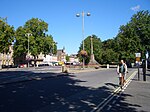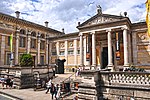Balliol College () is a constituent college of the University of Oxford. Founded in 1263 by John I de Balliol, it has a claim to be the oldest college in Oxford and the English-speaking world. Balliol has a long history of innovation. It was one of the first Oxford colleges to appoint a Fellow in English, a Tutorial Fellow in Computer Science and was a founding college for Classical Archaeology and Ancient History. Famously, it was the birthplace of PPE in the 1920s and A. D. Lindsay, later master, played a key role in establishing the degree. In 2006, 45% of Balliol undergraduates obtained First Class degrees, a record within Oxford at the time.Members of Balliol have been awarded 13 Nobel Prizes with 12 Laureates (the most of any Oxford college). Balliol has educated four Prime Ministers of the United Kingdom (the second highest of any Oxford college), Harald V of Norway, Empress Masako of Japan, President Richard von Weizsäcker of Germany, Seretse Khama of Botswana, several Lords of Appeal in Ordinary, 7 Archbishops of Canterbury and 2 Cardinals. Balliol alumni also include the astronomer James Bradley, legal figures Lord Bingham and John Marshall Harlan II, geneticist Baruch Samuel Blumberg, writers Robert Southey, Gerard Hopkins, Matthew Arnold and Algernon Swinburne, historians R. H. Tawney, Christopher Hill and James H. Billington and philosopher Derek Parfit. Among the most famous students are the "Father of Economics" Adam Smith, the leader of the Baháʼí Faith Shoghi Effendi, the biologist Julian Huxley and his son Aldous Huxley, the author of Brave New World.John Wycliffe, who oversaw the first complete translation of the Bible into English, was master of Balliol in the 1360s. Due to the college's antiquity, knowledge of membership before around 1630 is incomplete, though eminent figures like Sir Thomas More and Humphrey, Duke of Gloucester have been suggested as potential students. Through his friendship with master Benjamin Jowett, the poet Robert Browning became the college's first Honorary Fellow.When John de Balliol died in 1268, his widow, Dervorguilla (whose wealth far exceeded that of his own) continued his work in setting up the college. It fell to Dervorguilla to confirm the foundation, with the blessing of the Bishop as well as the University hierarchy. She established a permanent endowment for the College in 1282, as well as its first formal Statutes. She is thus considered the co-founder of the college, and is commemorated through the Dervorguilla Society, and the annual Dervorguilla Seminar Series, while a Latin Requiem Mass was sung at Balliol for the 700th anniversary of her death.










